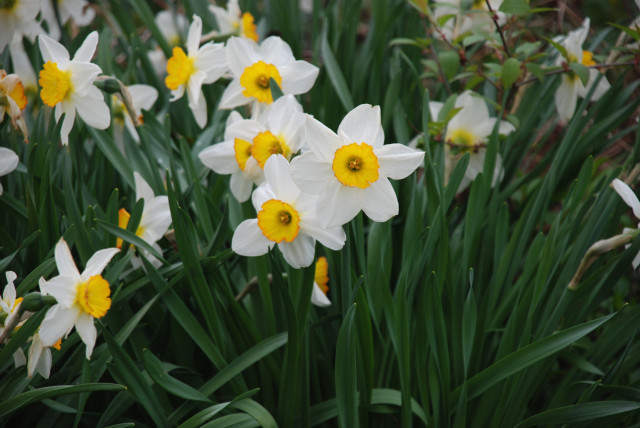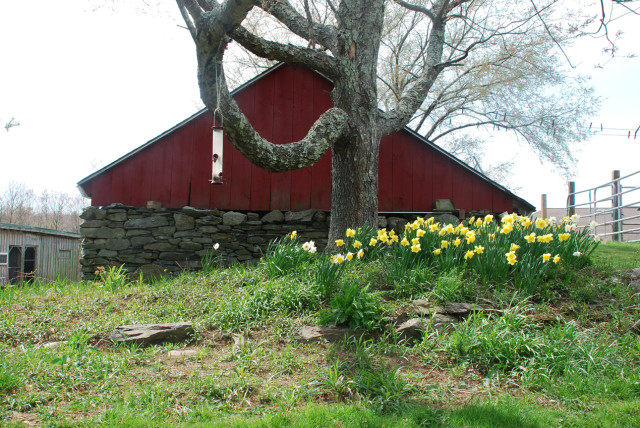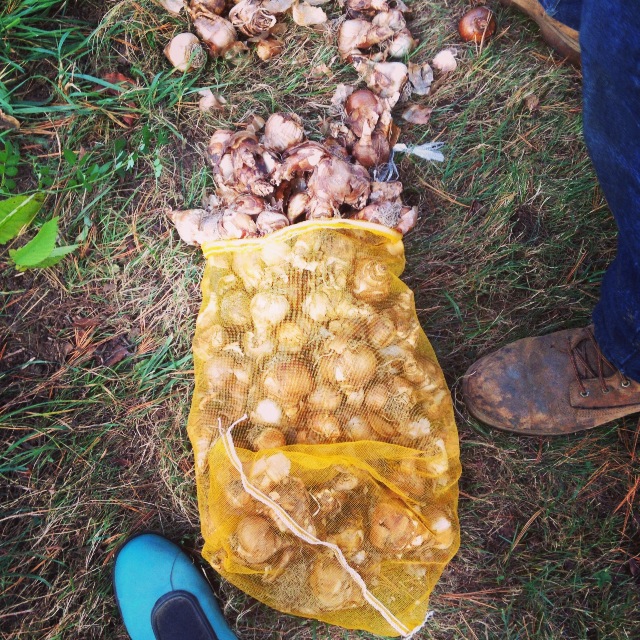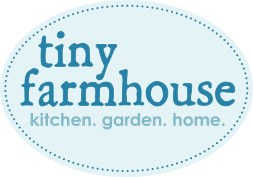
Daffodils are the tenth wedding anniversary flower, so, this year, on our tenth wedding anniversary (who are we to buck tradition?), we ordered 100 daffodil bulbs to fill out the very unkempt garden that sits right in front of our barn.
The garden is also directly in front of our kitchen window, though at a bit of a distance. Still, while we’re making coffee in the morning, it is our first view of the day.
In the spring, the garden is cheery, with a smattering of daffodils on one half of the garden, planted well before I moved in, and before JR purchased the property. We estimate that those bulbs were planted in the mid-80’s, and each year, they multiply nicely, filling in more and more, however, they haven’t quite multiplied to the point where they have migrated to the daffodil deprived part of the garden, and this year, with our anniversary as a happy excuse, we decided to help that cause along.
In another, slightly more unkempt garden in the front of the house, we had great success with a naturalizing mix of daffodils from White Flower Farm. Our initial planting of 100 bulbs more than a decade ago has rewarded us with larger and larger yields, multiplying every year.
One hundred bulbs does sound like a lot of digging is involved, and if you need to dig up sod to establish your daffodil bed, it will be a fair amount of work, but JR and I spent about 1 hour prepping the garden bed, which had become overrun with weeds and the occasional poison ivy vine, and which also had a number of plants that we wished to keep, like coreopsis, day lilies, and fraises des bois strawberries. So the soil was easy to work, but there were other plants that we needed to avoid ripping up as we weeded.
When it came time to plant, the two of us split up the garden area, with each of us planting half of the bulbs. Fifty bulbs each took us just over an hour, so it’s safe to assume 2 ½ to 3 man-hours total for 100 bulbs once your bed is prepped, depending upon how quickly you work. Still, if you’re able to divvy up the task, spending an hour to an hour and a half digging and burying bulbs is a small price to pay for the display in the spring.

this is going to look so much better in the spring – and for many springs to come – with only a few hours of work invested. Sweet.
No special equipment is needed – just a shovel or a spade will do, but be sure that you’re planting in an area with well-drained soil, as the bulbs will rot in heavy soil that holds water (so avoid that spot in your yard that always fills up when the rain comes, or the spot where the snow melts last).
Daffodil bulbs look quite similar to shallots, only with a copper-brown skin instead of that purple-ish/mauve tint. The leaves and flowers will emerge from the pointed end (much as they would from a shallot, onion, or garlic), and the root end is to be placed facing down. For those of you with more experience with bulbs, I know you’ll forgive the description, as we all start somewhere.
Dig a hole 6 to 8 inches deep, and wide enough for the bulb to be easily placed into it. Bulbs will find their own level if you have a few challenging spots in which to plant, though best to try for the proper depth to start. Some of our 1980’s bulbs are quite close to the surface, actually, and they still put on a show without issue.
Plant your daffodil bulbs 4 to 6 inches apart, with the root end of the bulb sitting in the base of the hole, and the narrow tip of the bulb facing the sky.
Cover the bulb, tamp down the soil, and move on to the next. Once all of the bulbs are planted, water generously. It’s ideal to do this right after planting, but be sure to do so before the frost comes.
Daffodils contain poisonous crystals, which keep deer, squirrels, and voles from eating them (fabulous!). However, if you have particularly industrious squirrels in your yard, you may want to sprinkle crushed red pepper flakes (they really are good in everything!) around the area you’ve planted, or you can cover the area with chicken wire or mesh, secure the wire to the ground, and cover it with mulch so that you see only lovely daffodils – not wire – when the bulbs emerge in the spring.
We are getting to the very end of the window of opportunity for planting daffodils here in southeastern Massachusetts, we managed to get ours in the ground two weeks ago, during the first weekend of November, so if your soil can still be worked, you, too, can get it done. Just be quick to get bulbs, and get digging straight away.
One bit of warning for those who live in very warm regions: daffodils will not bloom in areas where there is no frost. However, there are bulb collections designed specifically for warmer climates (please see the links below).

Helpful links:
White Flower Farm – we have bought “The Works” twice. At $56 for 100 bulbs, this is also a very cost-effective collection. Obviously. Their “Professional’s Naturalizing Mix” is the same price, with slightly smaller bulbs, which makes them a little easier to plant.
White Flower Farm provides a bulb growing guide here which includes information on soil pH, sunlight requirements, and a calendar of care.
The American Daffodil Society has a list of general daffodil merchants, and this list does include some international resources.
For you southern gardeners, The Southern Bulb Company will be of interest. They stock rare and heirloom daffodil (narcissus) bulbs that thrive in the South.
For daffodil growers in the United Kingdom, there is the Daffodil Society, with planting tips, suppliers, and daffodil news, as well as information on daffodil shows. The Royal Horticultural Society provides a resource list for daffodils as well.

I adore this idea for an anniversary gift – really lovely! I am going to check out those bulb companies as well since the garden shops near us are so expensive when it comes to bulbs. Thanks for the tips!
Thank you, Denise! Daffodils can be very pricey, and if we weren’t trying to cover so much ground (literally), I might be more on board with spending more for bulbs, but when you want a big, lush display, better to go for the deal. Especially if they look as lovely as these ones do in the end!
please do share the after pix this coming spring!
i’ve ordered from White Flower Farm before, they are fabulous. i’ve been thinking very very seriously about treating myself to an indoor citrus tree and WFF has a great selection…
Hi Lan! I will definitely share the after photos! White Flower Farm is really good, and as soon as I read “indoor citrus tree”, I started to feel envious! They do have a great selection! What do you think you’ll get? I always stare at the Meyer lemon tree and dream of it in a big, Tuscan terra cotta pot, sitting next to our (imaginary) indoor olives. Mmmmmm. But, then, the key lime tree would be awesome, too. Or the orange. I can just imagine the scent of any of them improving one’s outlook on winter.